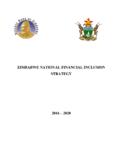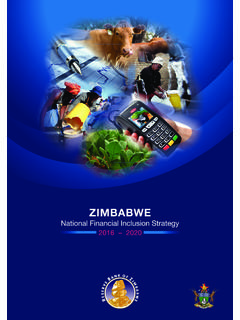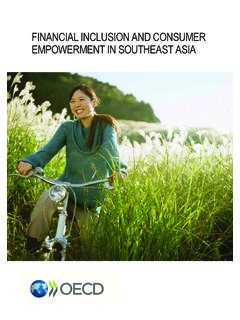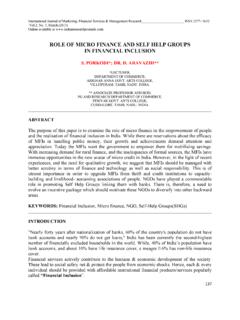Transcription of Analysis of the Level of Financial Literacy and Financial ...
1 IOSR Journal of Economics and Finance (IOSR-JEF) e-ISSN: 2321-5933, p-ISSN: 6, Issue 4. Ver. I (Jul. - Aug. 2015), PP 38-42 DOI: 38 | Page Analysis of the Level of Financial Literacy and Financial Inclusion among Rural Households in Krishna District: Andhra Pradesh Dr. P. Raja Babu Associate Professor, Dept. of MBA, KL University Business School, KL University, Vaddeswaram, Guntur District-522 502, Andhra Pradesh, India Abstract: Financial Literacy is the base and primary step for Financial inclusion. It provides knowledge on merits and demerits of Financial products and services, based on that an individual can select the right product which suits his/her needs. In the words of Shri Pranab Mukherjee, (2013) Financial Literacy refers Financial Literacy and education plays a vital role in Financial inclusion, inclusive growth and sustainable prosperity.
2 It ensures that Financial services are to be reached to weaker sections or unreached sections of the society. All the initiatives should aim at achieving Financial inclusion through Financial Literacy . For improving awareness of Financial Literacy , several schemes were implemented by the Reserve Banking of India, the Security and Exchange Board of India, Insurance Regulatory Development Authority, Pension Fund Regulatory and Development Authority (PFRADA). These bodies are engaged in various Financial education programs in improving Financial Literacy thereby achieving Financial inclusion. Various strategies are also being implemented for the improvement of Financial Literacy in India. These include introducing Financial education in school curriculums especially government schools in rural areas, and Financial - Literacy training programs set up by commercial banks in urban and semi-urban areas.
3 Village adoption programs were also established by educational institutions in rural areas. There is a strong concern for banks to arrange regular campaign through media and road shows to spread awareness about Financial inclusion and Financial Literacy . The main objective of this study is to know the Level of Financial literacyamong rural households in Krishna District, Andhra Pradesh and banking penetration in selected mandals. Key words: Financial inclusion, Financial Literacy , index of Financial inclusion, banking population I. Introduction Financial Literacy In India In developing economies like India, more than 60 per cent of the population who lives in rural areas should ensure adequate access to Financial products and services. By the end of March 2013, it was found that 59 percent of the adults have bank accounts, where as in rural areas it is 39 per cent.
4 For this, the Financial Stability and Development Council (FSDC), led by the Finance Ministries mandated to focus on Financial inclusion and Financial Literacy . Financial Literacy Centers were established in June 2012 by the Reserve Bank of India. As per new guidelines of the RBI, all commercial banks should conduct awareness camp at least once in a month. Accordingly, by the end of March 2013, 718 Financial Literacy Centers have been set up and million people have been educated through awareness camp (Richa Aggarwal, 2014). In the same way apex bodies, viz., the RBI, the SEBI and IRDA committed to the mission to create a financially aware and empowered India to improve Financial Literacy thereby achieving Financial inclusion in India. Financial Literacy In Krishna District Three Financial Literacy centres were set up in Krishna District, Andhra Pradesh.
5 The first centre is in Machilipatnam, the second centre is located in Gudiwada under the guidelines of SapthagiriGrameena Bank and the third centre was located in Vijayawada, Lead Manager office, at Indian Bank Zonal Office. The fourth Centre is proposed in Nuziveedu. Benefits For Financial Inclusion Financial inclusion benefits in two ways, one is profitability to the banker and the latter is to serve the social cause by bringing the poor and the marginalized into Financial loop. The RBI (2008) denotes well-functioning of Financial system to create identical opportunity, integrate economically and socially excluded people so as to actively contribute to development and protect themselves against economic shocks. Financial inclusion is closely related to the development of other physical facilities and infrastructure in the state such as roads, electricity, dams and bridges.
6 In the absence of above facilities, the demand for credit goes down and Analysis Of The Level Of Financial Literacy And DOI: 39 | Page many business activities can t be performed. As a result, Financial inclusion declines. Hawkins. P, (2010) denotes that government also is responsible to promote Financial inclusion in marginalised rural sections. Financial inclusion entails the following benefits. i. It helps the poor to avail a variety of saving and loan products which were far-reachingearlier. ii. It facilitates effective allocation of productive resources. iii. It reduces the K (cost of capital) to remit fund at low cost. iv. It improves day-to-day management of finance through providing access to Financial services. v. It ensures transfer of funds more safely and easily by using cheque, demand drafts or through internet banking.
7 Vi. Provides social benefits including protection against losses, improved mechanisms for social transfers and economic linkages for rural development. Further, Financial inclusion is a passport for other Financial products and services such as short term credit facilities, insurance and pension products as they necessarily require access to bank account. Financial Inclusion provides database for individual borrowers to capture loans, multiple lending and excess borrowings expressed in a report on Issues and Concerns in the Micro Financial Institutions by Shri Y H Malegam, (2011). Amartyan Sen, (2000) persuasively argued that the reason for poverty is not just insufficient income, but its lack of wide range of capabilities, security and ability to partake in economic and political system. II. Objectives Of Financial Inclusion For sustainable development, growth of an economy and to attain objectives of productive and competitive economy, there is a need for robust and strong Financial system.
8 India has the largest rural population, so an innovative technique has to be employed to promote banking habits. Financial inclusion is an innovative term in promoting banking habits (Richa Aggarwal, 2014). Financial inclusion emphasizes various dimensions including availability, accessibility and usage of Financial system. It helps to improve an overall inclusive Financial system. The main objective of Financial inclusion is to ensure ease of access, availability and usage of Financial system for all individuals of an economy. Finally, expansion of the scope of organized Financial system is within its range of people with low income. Financial inclusion has served as a guide for policy and regulatory approaches with the objectives of providing innovative, adequate, low-cost Financial delivery and various banking insurance services at reasonably priced and quality of Financial services G20 (Group of Twenty).
9 Approaches Of Financial Inclusion: According to C. Rangarajan the following approaches in the system of Financial inclusion are; i. To provide a need-based credit facility to the marginal and sub-marginal farmers. ii. To open need-based branches across the country. iii. To open the branches based on population per branch is more than the national average of commercial banks. iv. To simplify the procedure for granting of loans to small borrowers. v. To strengthen Self Help Group-Bank Linkage Programme (SHBLP) and facilitation of business correspondent models need to be effectively implemented. Objectives Of The Study: The research aims to cover the following objectives To know the Level of Financial Literacy among rural households in Krishna District, Andhra Pradesh and To examine banking population in selected mandals.
10 III. Methodology Of The Study It is planned to select 25 Mandals of Krishna district by giving representation to all the 25 mandal belts of Krishna district, viz. mandal villages and so on. Taking population as a base, 25 mandals are selected for the survey. For each mandal, 30 respondents are approached as these mandals have the highest population in their respective populations for the study in Krishna District are households of agricultural daily wage earners. Total population of Krishna District, Andhra Pradesh was 45, 17, 398 as per the census of 2011, density of population (people per square km) is 518. Total mandals and total villages are 49 and 985 respectively. Status Of Index Of Financial Inclusion In Selected Mandals Banking penetration: An inclusive Financial system should penetrate widely among its users. In the context of index of Financial inclusion Table:01 can be calculated as mandal wise banked population.
















